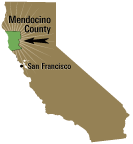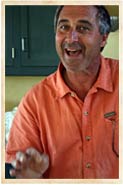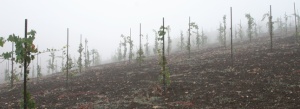I met with Mendocino growers this week and sampled some of their tastiest “green” crop.
The buzz you get from this “green” is totally legal. It comes from a part of wine country punctuated by biodynamic and sustainably farmed vineyards. Nearly one quarter of the grapes grown here are organic — the highest concentration in the state.
There are 84 commercial wineries, starting at the Mendocino county line (about 90 miles north of San Francisco). The three largest grape-growing regions are Anderson Valley, Potter Valley, and Redwood Valley.
Mendocino is home to:
*Cole Ranch, the country’s smallest AVA (American Viticultural Area), which has only 187 acres and one winery.
*Greenwood Ranch Winery, which is is totally off the grid. It’s been completely solar powered since 2005.
* Parducci, which became California’s first “carbon-neutral” winery in 2007. The winery was able to balance its carbon-based emissions with an equal amount of renewable energy for a net-zero impact on the environment.
The Mendocino Winegrape & Wine Commission sponsored a tasting at the Presidio in San Francisco where 58 wineries poured samples for trade and media. It was a veritable smorgasbord of wine types and styles. Several special bottles caught my eye, starting with two very good wines from Chiarito Vineyards.
The Chiarito 2007 Nero d’Avola (made from a grape that’s native to Southern Italy) is a smooth-tasting, fruit-forward red wine ($36) that could compete on equal terms with most of the Nero wines that I’ve tasted from overseas. Only 48 cases were made.
John Chiarito, the winemaker, poured a glass of his 2007 petite sirah — a grape that came from France — and it was heavenly. Many petite sirah wines are harsh, tannic and out of control, but the Chiarito ($35) was silky yet powerful. It tasted of sweet cherries with a touch of fennel. Click here for a closer look at petite sirah in California.
Another Italian varietal, dolcetto, made by Naughty Boy Vineyards is a great buy at $16.50/bottle for the 2007 vintage. This red wine grape — best known in Italy’s Piedmonte region — comes from a three-acre vineyard in Potter Valley. It’s a mildly tannic wine that pairs nicely with meat and cream-sauced pasta dishes. A total of 400 cases were produced.
Pinot noir is the fair-haired child in the Mendocino wine world right now and I like what the crew at Londer Vineyards is doing with their pinot lineup, especially the 2007 Anderson Valley bottling ($35). True to varietal form, this pinot noir tasted of red cherries with a spicy overtone that sat like a dollop of cream on a decadent sundae.
Another top-flight producer, Claudia Springs, is a two-person operation. It’s just winemaker Bob Klindt and his wife, Claudia. Their pinot noirs are good, but I was more entranced by an amazing zinfandel that comes from Valenti Ranch Vineyard.
The 2006 Valenti Ranch zinfandel ($28) is quite high in alcohol (17.8 percent) but the jammy fruit carried the day and the wine’s aftertaste lingered for what seemed like forever in my mouth. I’d drink it with barbecued meats, spicy pasta dishes or with a plate of rustic bread and strong cheese.
Claudia Springs also produces a tiny amount of fine zinfandel from the John Ricetti Vineyard, a one-acre plot tended by the owner, 93-year-old John Ricetti, whose family has been growing grapes in this region since the early 1900s. The 2007 vintage ($24) showcases the chocolate facet of the varietal with highlights of blackberries and plums. Only 124 cases were made.
The best bargain wine of the tasting was the 2006 Sustainable Red from Parducci Wine Cellars ($11). It’s a blend of 30 percent zinfandel, 30 percent cabernet sauvignon, 30 percent syrah and 10 percent petite sirah. I’d call it an everyday wine that delivers great value for the price. Good on its own or with simple foods like pizza and burgers.
Parducci — the oldest winery in Mendocino — is one of the most eco-friendly wineries in the country and was the recipient of the 2009 Governor’s Environmental and Economic Leadership Award (GEELA).





